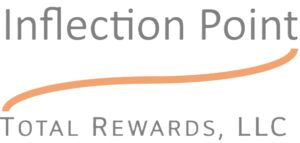Developing A Strategic Total Rewards Approach

By Sharona Abramson, Inflection Point - Total Rewards, LLC
All companies face the challenge of attracting and retaining good talent and appealing to an employee population that is diverse in what it wants and needs. Taking a thoughtful approach to total compensation ensures that money and resources will be well-spent, well-received, externally competitive, and internally equitable. Below are some key guideposts for building a total rewards approach that addresses the following key elements:
- Total Rewards Philosophy and Strategy
- Base Salary
- Incentives
- Health and Welfare Benefits
- Retirement Benefits
- Training and Development
- Culture
Let’s take a minute to explore each:
- Total Rewards (TR) Philosophy and Strategy.
A TR philosophy and strategy tells the world what competitive positioning is, and how you want to compensate your employees. It talks about base salary, incentives, and benefits as well as your philosophy for administering them. As you draft it, consider and discuss where you want to meet, lag, or exceed the market. Also articulate how compensation is set and what causes it to change. - Salary Structure and Job Architecture.
With the TR philosophy and strategy in place, you can build some simple foundations. Start by conducting a thorough market analysis of jobs and peg these to your salary structure. A salary structure defines the relationship of your company’s jobs to the market and to each other. While not always necessary, having a simple salary structure and pay ranges provides a clear framework and market reference for decision making and communication. Another key element is job architecture. A job architecture is a set of levels and definitions for jobs that drive allocation of benefits, short and long-term incentives, as well as career progression. Your salary structure should integrate with your job architecture. Both should be just detailed enough to guide and promote career mobility and pay transparency but as simple as possible to administer and communicate. - Incentive Plans. in order to motivate employees and tie their efforts with company goals, consider developing or strengthening your existing performance-based incentive plans. This is a low hanging fruit and quick hit with lots of leverage. Clear performance metrics and goals should be defined, aligned with each of the company’s strategic objectives, and prioritized so not only the right “ingredients” are chosen but the whole “recipe” works together. And don’t forget eligibility criteria and proration to make it fair and consider timing of payout. Build clear and engaging launch and results communications and provide meaningful updates to employees to help them understand the potential payout and stay engaged in reaching goals.
- Health and Welfare Plans. Spend time understanding employee needs so you can maximize your benefit spend–however large or small your budget. Outline your needs and leverage your broker relationships to tailor benefit plans to these unique needs. And don’t forget to customize offerings based on generational appeal. Then, by creating an engaging wellness plan, you can promote healthy habits and self-care to reduce claims experience and also strengthen your culture. For example, a free weight loss program and step (walking) challenges are low-cost solutions to driving down claims associated with diabetes and hyperlipidemia and sparking some healthy competition. And think about work-life balance, whenever possible. It is key to encouraging productivity, engagement, and remaining competitive in a post-COVID labor market.
- Investment and Savings. To demonstrate your commitment to employee long-term well-being, fortify your existing 401(k) with an employer match, if possible. Allowing match dollars to alternatively flow into an employee loan repayment program may appeal more to younger workers. Augment these with financial literacy programs, if possible, to help drive some good financial planning and lifestyle choices.
- Training and Development. Recognize the importance of upskilling your employees. Invest in ongoing training programs, both formal and informal. and consider implementing claw back provisions for formal education to maximize employee retention. A job architecture can help you track progression in development and communicate it to employees.
- A good corporate culture is like superglue when it comes to retention and retention. Recognize the need to create an environment where employees feel valued and motivated to contribute to the overall success of the organization. Make sure your employees understand where the company is going and how you plan to get there. Consider implementing programs that create meaningful opportunities for employees to connect and collaborate with each other and feel like they are part of a team. Mentorship, recognition, and volunteering opportunities foster connectedness and a sense of teamwork as well, so include these when you can.
Designing and implementing a comprehensive total rewards approach can go a long way toward reducing turnover, bolstering engagement, and improving recruitment. By taking a thoughtful and holistic approach and tying your compensation to company goals and employee needs, you can successfully position your company as an employer of choice.


Sharona is an HR leader with extensive experience in Total Rewards, specifically, compensation, benefits, HRIS, and global mobility. Her broad experience spans various industries, among them technology (SaaS and IaaS), venture capital, healthcare, manufacturing, chemical processing, insurance, and market research. Throughout her career, she has demonstrated a track record of success in supporting complex business transformation initiatives and M&A transactions. She approaches her projects with a strategic foundation, disciplined project planning, and an emphasis on change management and communication coupled with disciplined execution. She has worked for companies ranging in size from 250 to 26,000 employees and has led total rewards in several mid-sized enterprises. Sharona is certified as a Senior HR Professional through HRCI. In her free time, Sharona enjoys spending time with her family, hiking, camping, walking and enjoying the outdoors but has a particular addiction to pickleball.
sharona@inflectionpointtr.
(773) 895-8360
Related Posts
7 Strategic Planning Steps to Make Your Company a Future Success
Are you missing Strategic Planning? Let’s quickly get through the first three items in any strategic plan. Here’s a quick
Protecting Your Law Firm
As we’ve worked increasingly with law firms over the past few years, there are a number of commonalities that we’ve
Get Clarity On Your
Company’s Performance
Our people are unique CFOs. They are all operationally
based financial executives.












